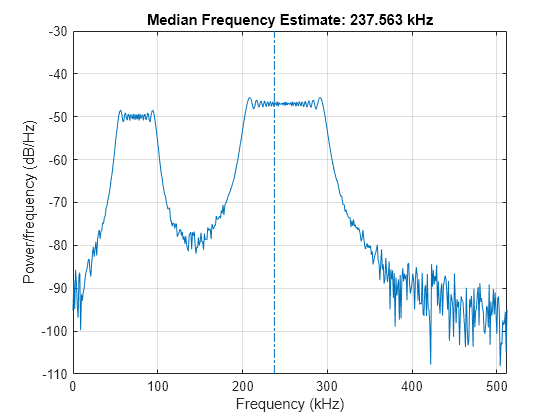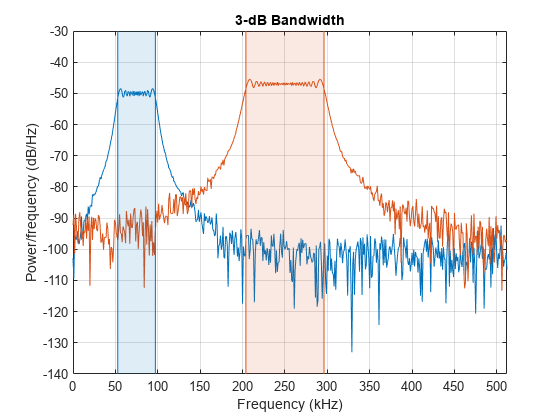测量均值频率、功率、带宽
生成以 1024 kHz 采样的啁啾信号的 1024 个采样点。啁啾信号的初始频率为 50 kHz,采样结束时达到 100 kHz。添加高斯白噪声,使信噪比为 40 dB。
nSamp = 1024; Fs = 1024e3; SNR = 40; t = (0:nSamp-1)'/Fs; x = chirp(t,50e3,nSamp/Fs,100e3); x = x+randn(size(x))*std(x)/db2mag(SNR);
估计信号的 99% 占用带宽,并在功率频谱密度 (PSD) 图上进行标注。
obw(x,Fs);

计算频带中的功率,并验证它是否占总数的 99%。
[bw,flo,fhi,powr] = obw(x,Fs); pcent = powr/bandpower(x)*100
pcent = 99.0000
生成另一个啁啾信号。指定其初始频率为 200 kHz、最终频率为 300 kHz,振幅为第一个信号的两倍。添加高斯白噪声。
x2 = 2*chirp(t,200e3,nSamp/Fs,300e3); x2 = x2+randn(size(x2))*std(x2)/db2mag(SNR);
将两个啁啾信号相加以形成一个新信号。绘制信号的 PSD,并标注其中值频率。
medfreq([x+x2],Fs);

绘制 PSD 并标注其均值频率。
meanfreq([x+x2],Fs);

现在假设每个啁啾信号代表一个单独的通道。估计每个通道的均值频率。在 PSD 图上标注其均值频率。
meanfreq([x x2],Fs)

ans = 1×2
105 ×
0.7503 2.4999
估计每个通道的半功率带宽。在 PSD 图上标注 3-dB 带宽。
powerbw([x x2],Fs)

ans = 1×2
104 ×
4.4386 9.2208